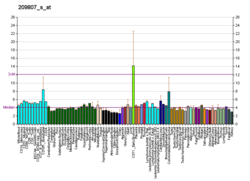NFIX
Nuclear factor 1 X-typeis aproteinthat in humans is encoded by theNFIXgene.[5][6][7]NFI-X3, asplice variantof NFIX, regulatesGlial fibrillary acidic proteinandYKL-40inastrocytes.[8]
Interactions
[edit]Nfix has been shown tointeractwithSKI protein[9]and it is also known to interact withAP-1.[8]NFI-X3 has been shown to interact withSTAT3.[8]
In embryonic cells, Nfix has been shown to regulateintermediate progenitor cell (IPC)generation by promoting the transcription of the protein inscuteable (INSC). INSC regulates spindle orientation to facilitate the division ofradial glia cellsinto IPC's. Nfix is thought to be necessary for the commitment of glia progeny into the intermediate progenitors. Mutations may cause overproduction of radial glia, impaired and improperly timed IPC development, and underproduction of neurons.[10]
In adult development, the timing of neural differentiation is regulated by Nfix to promote ongoing growth of thehippocampusand proper memory function. Nfix may suppressoligodendrocyteexpression so cells remain committed to neuron development within thedentate gyrus.Intermediate progenitor cells can divide to produceneuroblasts.Neurons produced by Nfix null IPC's do not mature, usually die, and can contribute to cognitive impairments.[11]
Nfix interacts withmyostatinand regulates temporal progression of muscle regeneration through modulation of myostatin expression. Nfix also inhibits the slow-twitch muscle phenotype.[12][13]
References
[edit]- ^abcGRCh38: Ensembl release 89: ENSG00000008441–Ensembl,May 2017
- ^abcGRCm38: Ensembl release 89: ENSMUSG00000001911–Ensembl,May 2017
- ^"Human PubMed Reference:".National Center for Biotechnology Information, U.S. National Library of Medicine.
- ^"Mouse PubMed Reference:".National Center for Biotechnology Information, U.S. National Library of Medicine.
- ^Seisenberger C, Winnacker EL, Scherthan H (July 1993). "Localisation of the human nuclear factor I/X (NFI/X) gene to chromosome 19p13 and detection of five other related loci at 1p21-22, 1q42-43, 5q15, 11p13 and 20q13 by FISH".Human Genetics.91(6): 535–537.doi:10.1007/bf00205076.PMID8340106.S2CID22365562.
- ^Qian F, Kruse U, Lichter P, Sippel AE (July 1995). "Chromosomal localization of the four genes (NFIA, B, C, and X) for the human transcription factor nuclear factor I by FISH".Genomics.28(1): 66–73.doi:10.1006/geno.1995.1107.PMID7590749.
- ^"Entrez Gene: NFIX nuclear factor I/X (CCAAT-binding transcription factor)".
- ^abcSingh SK, Bhardwaj R, Wilczynska KM, Dumur CI, Kordula T (November 2011)."A complex of nuclear factor I-X3 and STAT3 regulates astrocyte and glioma migration through the secreted glycoprotein YKL-40".The Journal of Biological Chemistry.286(46): 39893–39903.doi:10.1074/jbc.M111.257451.PMC3220556.PMID21953450.
- ^Tarapore P, Richmond C, Zheng G, Cohen SB, Kelder B, Kopchick J, et al. (October 1997)."DNA binding and transcriptional activation by the Ski oncoprotein mediated by interaction with NFI".Nucleic Acids Research.25(19): 3895–3903.doi:10.1093/nar/25.19.3895.PMC146989.PMID9380514.
- ^Harris L, Zalucki O, Gobius I, McDonald H, Osinki J, Harvey TJ, et al. (December 2016)."Transcriptional regulation of intermediate progenitor cell generation during hippocampal development".Development.143(24): 4620–4630.doi:10.1242/dev.140681.PMC5201028.PMID27965439.
- ^Harris L, Zalucki O, Clément O, Fraser J, Matuzelski E, Oishi S, et al. (February 2018)."Neurogenic differentiation by hippocampal neural stem and progenitor cells is biased by NFIX expression".Development.145(3): 1–12.doi:10.1242/dev.155689.PMID29437824.
- ^Omairi S, Matsakas A, Degens H, Kretz O, Hansson KA, Solbrå AV, et al. (August 2016). Cossu G (ed.)."Enhanced exercise and regenerative capacity in a mouse model that violates size constraints of oxidative muscle fibres".eLife.5:e16940.doi:10.7554/eLife.16940.PMC4975572.PMID27494364.
- ^Rossi G, Antonini S, Bonfanti C, Monteverde S, Vezzali C, Tajbakhsh S, et al. (March 2016)."Nfix Regulates Temporal Progression of Muscle Regeneration through Modulation of Myostatin Expression".Cell Reports.14(9): 2238–2249.doi:10.1016/j.celrep.2016.02.014.PMC4793149.PMID26923583.
Further reading
[edit]- Apt D, Liu Y, Bernard HU (September 1994)."Cloning and functional analysis of spliced isoforms of human nuclear factor I-X: interference with transcriptional activation by NFI/CTF in a cell-type specific manner".Nucleic Acids Research.22(19): 3825–3833.doi:10.1093/nar/22.19.3825.PMC308376.PMID7937100.
- Sumner C, Shinohara T, Durham L, Traub R, Major EO, Amemiya K (April 1996). "Expression of multiple classes of the nuclear factor-1 family in the developing human brain: differential expression of two classes of NF-1 genes".Journal of Neurovirology.2(2): 87–100.doi:10.3109/13550289609146542.PMID8799200.
- Wendler WM, Kremmer E, Förster R, Winnacker EL (March 1997)."Identification of pirin, a novel highly conserved nuclear protein".The Journal of Biological Chemistry.272(13): 8482–8489.doi:10.1074/jbc.272.13.8482.PMID9079676.
- Liu Y, Bernard HU, Apt D (April 1997)."NFI-B3, a novel transcriptional repressor of the nuclear factor I family, is generated by alternative RNA processing".The Journal of Biological Chemistry.272(16): 10739–10745.doi:10.1074/jbc.272.16.10739.PMID9099724.
- Tarapore P, Richmond C, Zheng G, Cohen SB, Kelder B, Kopchick J, et al. (October 1997)."DNA binding and transcriptional activation by the Ski oncoprotein mediated by interaction with NFI".Nucleic Acids Research.25(19): 3895–3903.doi:10.1093/nar/25.19.3895.PMC146989.PMID9380514.
- Müller K, Mermod N (January 2000)."The histone-interacting domain of nuclear factor I activates simian virus 40 DNA replication in vivo".The Journal of Biological Chemistry.275(3): 1645–1650.doi:10.1074/jbc.275.3.1645.PMID10636857.
- Nakazato M, Chung HK, Ulianich L, Grassadonia A, Suzuki K, Kohn LD (November 2000)."Thyroglobulin repression of thyroid transcription factor 1 (TTF-1) gene expression is mediated by decreased DNA binding of nuclear factor I proteins which control constitutive TTF-1 expression".Molecular and Cellular Biology.20(22): 8499–8512.doi:10.1128/MCB.20.22.8499-8512.2000.PMC102156.PMID11046146.
- Imagawa M, Sakaue R, Tanabe A, Osada S, Nishihara T (November 2000)."Two nuclear localization signals are required for nuclear translocation of nuclear factor 1-A".FEBS Letters.484(2): 118–124.Bibcode:2000FEBSL.484..118I.doi:10.1016/S0014-5793(00)02119-0.PMID11068044.S2CID46556394.
- Norquay LD, Yang X, Sheppard P, Gregoire S, Dodd JG, Reith W, et al. (June 2003)."RFX1 and NF-1 associate with P sequences of the human growth hormone locus in pituitary chromatin".Molecular Endocrinology.17(6): 1027–1038.doi:10.1210/me.2003-0025.PMID12624117.
- Gopalan SM, Wilczynska KM, Konik BS, Bryan L, Kordula T (May 2006)."Nuclear factor-1-X regulates astrocyte-specific expression of the Alpha 1-antichymotrypsin and glial fibrillary acidic protein genes".The Journal of Biological Chemistry.281(19): 13126–13133.doi:10.1074/jbc.M601194200.PMID16565071.
- Ravichandran V, Sabath BF, Jensen PN, Houff SA, Major EO (November 2006)."Interactions between c-Jun, nuclear factor 1, and JC virus promoter sequences: implications for viral tropism".Journal of Virology.80(21): 10506–10513.doi:10.1128/JVI.01355-06.PMC1641797.PMID16928756.
External links
[edit]- NFIX+protein,+humanat the U.S. National Library of MedicineMedical Subject Headings(MeSH)
This article incorporates text from theUnited States National Library of Medicine,which is in thepublic domain.





